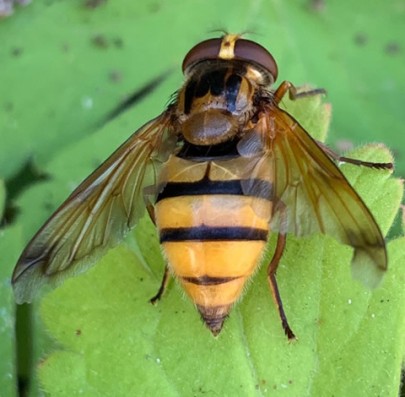Manaaki Whenua scientist Dr Bob Brown released the hoverflies on a farm in Rai Valley with support from local iwi, Marlborough District Council and Kotahitanga mo te Taiao (KMTT) Alliance. More hoverflies were released at a site in Wainui, with the release attended by Tasman District Council, iwi and the KMTT.

Volucella inanis female rests near a wasp nest entrance in Egham, England.
The hoverfly is a wasp-predator and the females lay their eggs in wasp nests. Once hatched, the fly larvae feed on wasp larvae and pupae. The flies have come a long way to help out. Bob collected an initial cohort of hoverflies in the south of England and brought them all the way to Lincoln’s Insect Containment Centre for testing.
“The hoverflies only feed on wasps,” says Bob. “They are not interested in bees or other insects.”
He cautions any noticeable success from the hoverfly releases may not be apparent for at least 18 months, and it is unlikely that vespid wasps will be eradicated from the district altogether. “However, it is hoped that the hoverfly will adapt to its new environment and cause wasp densities to decrease in the Top of The South,” says Bob.
German wasps were first found in Aotearoa New Zealand in 1945, and the common wasp first recorded in 1978. Since then, they have spread throughout the country, with the beech forests in Te Tauihu/Top of the South Island having the highest densities of wasps in the world. The impact on native wildlife is staggering as they attack everything from butterflies, moths, and spiders to bees as well as fledgling birds. It is estimated wasps cost Aotearoa up to $130 million per annum in damages and management.
The Vespula Biocontrol Action Group, which is made up of a wide range of stakeholders, from primary industries to councils to community groups, as part of a Ministry for Primary Industries Sustainable Farming Fund (SFF) grant started the process to look for a biocontrol agent in 2014.
Bob says the next step is to monitor the establishment progress of the hoverflies and then work towards further releases to build a sustainable population. “We’ve chosen sites that are a good distance apart in case unforeseen natural disasters destroy any of the sites, so we have a backup,” he says.
“It is not unusual to require several releases for a biological control agent to successfully establish.”
Partners
This work is a collaboration between Manaaki Whenua – Landcare Research, Tasman District Council, and the Vespula Action Group, as part of a Ministry for Primary Industries Sustainable Farming Fund. Support has also been provided by Manaaki Whenua's Strategic Science Investment Fund (SSIF) and the The Nature Conservancy Aotearoa New Zealand to facilitate the releases as part of the Kotahitanga mō te Taiao strategy.

